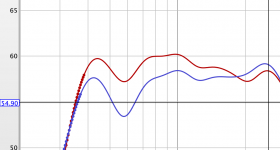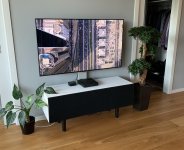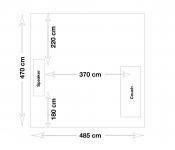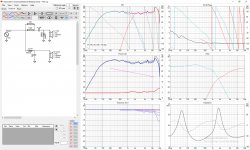Recently I made a tv-stand/stereo bench speaker with a pair of Seas CA22RNY and tweeters. Each side is 55 liters ported tuned to 35 Hz.
When finished I was surprised to find that there was hardly any bass.
After measuring and experimenting with removing the ports (leaving only the open hole) I was even more surprised to find that having the port in didn't provide any lower extension at all. See measurements below (red is with port removed).
I wonder if perhaps it is the brace that obstructs energy/airflow from the woofer to the port. Se picture of enclosure.
Any ideas?
When finished I was surprised to find that there was hardly any bass.
After measuring and experimenting with removing the ports (leaving only the open hole) I was even more surprised to find that having the port in didn't provide any lower extension at all. See measurements below (red is with port removed).
I wonder if perhaps it is the brace that obstructs energy/airflow from the woofer to the port. Se picture of enclosure.
Any ideas?
Attachments
A hole saw would test out your brace theory quickly 😀 It's not my first guess but it shouldn't lose any effectiveness if you opened up that back area of the brace, so why not?
Best guess first: is there any chance you have a highpass/ subsonic setting on that output somehow? Is there any DSP active? The fact that it cuts off at _exactly_ the same point points to this, IMO.
A quick check in winISD says you should be seeing considerably more extension below 50hz with e.g. a 7.6cm x 15cm port in place, vs a 7.6cm x 18mm (approx material thickness; box becomes ~58hz tuning with these dimensions) open hole, as you expected. For example, at 40 hz you should be seeing 7-8db more output with the port in place, and at 30hz you should see up to 12db! However the raised output between 50-100hz with the open hole suggests that the port is at least doing something. Hence my question about highpass filtering.
2nd guess: air leaks? I assume you've checked but if not, put the port back in, plug it with a tightly rolled towel, and play some 20hz at a low volume while feeling around and listening.
3rd guess: proximity to the ground is making the effective tuning much much lower than intended, with or without the port in place? Seems unlikely but easy to test by flipping the speaker over or on it's side.
4th and lamest, but still possible guess: are they wired out of phase with each other?
Best of luck!
P.s. you do_want_ a highpass filter in place, to prevent overexcursion below tuning, if you're going to run it at anything close to full power. You simply want to be in control of it ;D
Best guess first: is there any chance you have a highpass/ subsonic setting on that output somehow? Is there any DSP active? The fact that it cuts off at _exactly_ the same point points to this, IMO.
A quick check in winISD says you should be seeing considerably more extension below 50hz with e.g. a 7.6cm x 15cm port in place, vs a 7.6cm x 18mm (approx material thickness; box becomes ~58hz tuning with these dimensions) open hole, as you expected. For example, at 40 hz you should be seeing 7-8db more output with the port in place, and at 30hz you should see up to 12db! However the raised output between 50-100hz with the open hole suggests that the port is at least doing something. Hence my question about highpass filtering.
2nd guess: air leaks? I assume you've checked but if not, put the port back in, plug it with a tightly rolled towel, and play some 20hz at a low volume while feeling around and listening.
3rd guess: proximity to the ground is making the effective tuning much much lower than intended, with or without the port in place? Seems unlikely but easy to test by flipping the speaker over or on it's side.
4th and lamest, but still possible guess: are they wired out of phase with each other?
Best of luck!
P.s. you do_want_ a highpass filter in place, to prevent overexcursion below tuning, if you're going to run it at anything close to full power. You simply want to be in control of it ;D
Last edited:
Best guess first: is there any chance you have a highpass/ subsonic setting on that output somehow? Is there any DSP active? The fact that it cuts off at _exactly_ the same point points to this, IMO.
No DSP unfortunately. Optical from TV into digital amplifier (Nuforce DDA120)
A quick check in winISD says you should be seeing considerably more extension below 50hz with e.g. a 7.6cm x 15cm port in place, vs a 7.6cm x 18mm (approx material thickness; box becomes ~58hz tuning with these dimensions) open hole, as you expected. For example, at 40 hz you should be seeing 7-8db more output with the port in place, and at 30hz you should see up to 12db! However the raised output between 50-100hz with the open hole suggests that the port is at least doing something. Hence my question about highpass filtering.
Yep! That matches my simulations as well 😕
2nd guess: air leaks? I assume you've checked but if not, put the port back in, plug it with a tightly rolled towel, and play some 20hz at a low volume while feeling around and listening.
It seems completely airtight. You get the typical sealed enclosure spring effect when pushing on the woofer.
3rd guess: proximity to the ground is making the effective tuning much much lower than intended, with or without the port in place? Seems unlikely but easy to test by flipping the speaker over or on it's side.
I think the placement of the port in the corner of the enclosure probably lowers the effective tuning. But we should see a lower extension regardless having the port in.
4th and lamest, but still possible guess: are they wired out of phase with each other?
They're in phase 😉 Measurements are from a single woofer as well.
Sure looks like a suck out since port measurement goes down to ~Fs, Fb, so........
How did you measure?
Pertinent dims?
GM
How did you measure?
Pertinent dims?
GM
Hmm. Have you/can you try a source signal other than the TV; such as bluetooth to the DDA120 from your phone?No DSP unfortunately. Optical from TV into digital amplifier (Nuforce DDA120)
FWIW, I may not have been clear here; I meant have you tested in orientations other than 'down-firing' (with the port/hole and woofer against the floor)?I think the placement of the port in the corner of the enclosure probably lowers the effective tuning. But we should see a lower extension regardless having the port in.
Sure looks like a suck out since port measurement goes down to ~Fs, Fb, so........
How did you measure?
Pertinent dims?
GM
Listening position in room with REW and calibrated Dayton EMM-6 measurement mic.
The -3db point is indeed at about Fs of the woofer regardless of the ports being in or not.
What is weird is that I previously had a similar project with an Eminence CX10 in a smaller volume (30-35 liter) with a 50Hz tuning that had loads more bass (although not necessarily lower extension). The ports were closer to the floor with this one tho.
You would think this lesser efficient woofer in a larger cabinet with lower tuning would provide more bass 😕
Don't know what "Pertinent dims" means 😛
Hmm. Have you/can you try a source signal other than the TV; such as bluetooth to the DDA120 from your phone?
FWIW, I may not have been clear here; I meant have you tested in orientations other than 'down-firing' (with the port/hole and woofer against the floor)?
No difference with bluetooth. Unfortunately it's kinda hard to flip the whole thing considering the TV is mounted to the whole construction 😀
Last edited:
Haha, I hear you. I see you put healthy legs on those speakers, so I wouldn't think they're too close to the floor anyway. Not sure where I got the impression it was too close to the floor.No difference with bluetooth. Unfortunately it's kinda hard to flip the whole thing considering the TV is mounted to the whole construction
BTW I believe GM is asking for pertinent dim[ensions]; I'm not sure which ones they have in mind but perhaps more details about the listening/measurement position, room (dimensions, major openings in walls), and port (length, width & flare type if any)
Pertinent: Pertinent - Google Search
In your case, making a dimensioned drawing with all the cab's internal dimensions plus where the drivers, port are in relation to them, so we can figure out what its basic 'in room' eigenmodes are; and since measuring from the LP, need one of the room too including where the LP, any major acoustically reflected furniture/whatever is.
Re the vent on/off conundrum:
Your measurements implies that the vent is working correctly since the red line implies a much higher tuning being masked by the major dip [suck out] and the other rolling off to a [peaking] Fb that based on a similar alignment I did for this driver awhile back includes some significant room/boundary gain since my sim calcs a ~ -6.5 dB roll-off between its ~207 Hz mid band eff. Vs its 34 Hz Fb.
All this strongly implies a room suck out, so at this point more interested in a dimensioned room drawing or better, just let you try to find them 😉 [may be multiples summing together] by measuring any parallel panel/wall dimensions around ~34400/2/55 Hz = ~312.73 cm........... floor/ceiling creates strong suck outs in the [mid]bass, so got this high a ceiling?
Ditto at a 1/4 WL = ~34400/4/55 Hz = ~156.36 cm between the driver and any parallel or perpendicular to panel/wall.
Then there's floor/ceiling bounce, so check this first: Floor/Ceiling Reflection Calculator
Good luck!
GM
In your case, making a dimensioned drawing with all the cab's internal dimensions plus where the drivers, port are in relation to them, so we can figure out what its basic 'in room' eigenmodes are; and since measuring from the LP, need one of the room too including where the LP, any major acoustically reflected furniture/whatever is.
Re the vent on/off conundrum:
Your measurements implies that the vent is working correctly since the red line implies a much higher tuning being masked by the major dip [suck out] and the other rolling off to a [peaking] Fb that based on a similar alignment I did for this driver awhile back includes some significant room/boundary gain since my sim calcs a ~ -6.5 dB roll-off between its ~207 Hz mid band eff. Vs its 34 Hz Fb.
All this strongly implies a room suck out, so at this point more interested in a dimensioned room drawing or better, just let you try to find them 😉 [may be multiples summing together] by measuring any parallel panel/wall dimensions around ~34400/2/55 Hz = ~312.73 cm........... floor/ceiling creates strong suck outs in the [mid]bass, so got this high a ceiling?
Ditto at a 1/4 WL = ~34400/4/55 Hz = ~156.36 cm between the driver
Then there's floor/ceiling bounce, so check this first: Floor/Ceiling Reflection Calculator
Good luck!
GM
Last edited:
In your case, making a dimensioned drawing with all the cab's internal dimensions plus where the drivers, port are in relation to them, so we can figure out what its basic 'in room' eigenmodes are; and since measuring from the LP, need one of the room too including where the LP, any major acoustically reflected furniture/whatever is.
All this strongly implies a room suck out, so at this point more interested in a dimensioned room drawing or better, just let you try to find them 😉 [may be multiples summing together] by measuring any parallel panel/wall dimensions around ~34400/2/55 Hz = ~312.73 cm........... floor/ceiling creates strong suck outs in the [mid]bass, so got this high a ceiling?
Ditto at a 1/4 WL = ~34400/4/55 Hz = ~156.36 cm between the driverand any parallel or perpendicular to panel/wall.
Then there's floor/ceiling bounce, so check this first: Floor/Ceiling Reflection Calculator
Here's some drawings (see attached). Regarding the room, I didn't have problems with my previous speaker that was almost identical in size and placement of woofers.
I also tested a couple of bookshelf speakers the other day just placed on top that didn't have any bass issues.
Already checked floor/ceiling bounce and the first reflections doesn't match/show up on measurements. I reckon they are filled in by other room modes/reflections. Anyways, it's much higher in frequency.
Re the vent on/off conundrum:
Your measurements implies that the vent is working correctly since the red line implies a much higher tuning being masked by the major dip [suck out] and the other rolling off to a [peaking] Fb that based on a similar alignment I did for this driver awhile back includes some significant room/boundary gain since my sim calcs a ~ -6.5 dB roll-off between its ~207 Hz mid band eff. Vs its 34 Hz Fb.
The rising response and BSC is taken care of in crossover. See attached schematic and simulation. Woofer measurements are taken directly from Seas (which are done in a similarly sized cabinet and includes baffle step loss).
Attachments
Last edited:
Try putting in some pillows to take up volume - it’s a crude but effective way - make sure the source you are sending to them is a bass source - try one sub first light power to check Sound then manually phase them by adding other each way to see what is correct -
- Home
- Loudspeakers
- Subwoofers
- Getting weird behaviour with port lengths





